If you aren’t familiar with the wonderful book “For The Good of The Game” do yourself a big favor and find a copy. Unfortunately, this tome on how to referee is now out of print, but diligent searching should be able to find you a copy. Alternative corner kick positioning by the referee is one of the topics covered.
The authors are former FIFA Referees Ed Bellion and Robert Evans. They have long been considered the “renegades” of the US Soccer establishment because of their supposed “unorthodox” views on several aspects of refereeing.
One long running debate involves the position of the referee at a corner kick. USSF (and other national associations) have long held that referees should be roughly at the top of the penalty area, at about the intersection of the penalty arc and penalty area. Conventional wisdom dictates that this position allows the referee to keep pace with a quick counter-attack by the team defending the corner kick.
Ed and Robert have long advocated that the best position for a referee at a corner is on the goal line, near the goal post. They argue that this position allows the referee the best view of the action in front of goal, positions the referee perfectly for any tight calls on the goal line, and discourages shirt-pulling and other nonsense because of the proximity of the referee to the players.
Imagine how warm their hearts must have been, then, when they saw referee Mike Dean take up their recommended position in a recent Premier League match between Swansea and Reading.
I think this position makes a lot of sense, and, in fact, this was the recommended corner kick positioning long ago. Have you witnessed referees taking this position on a corner? What is your opinion on corner kick positioning?
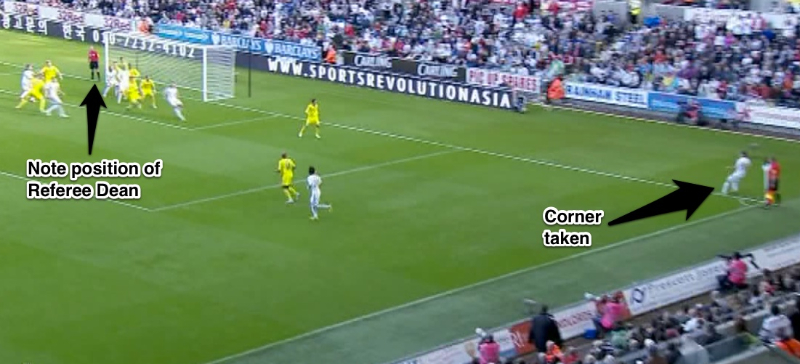
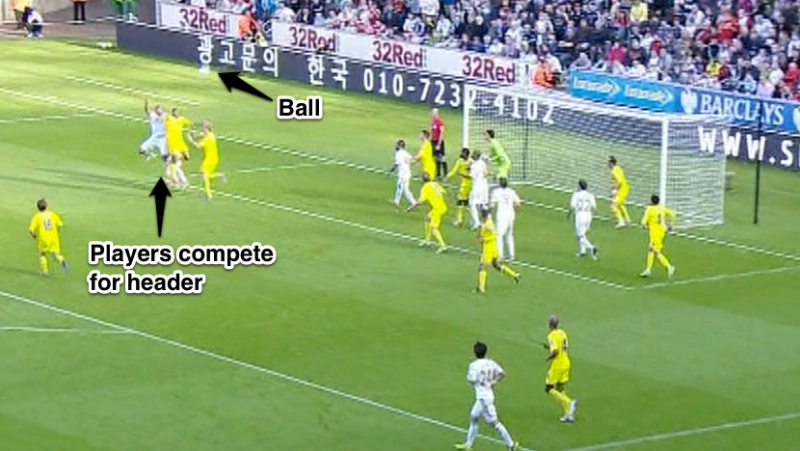
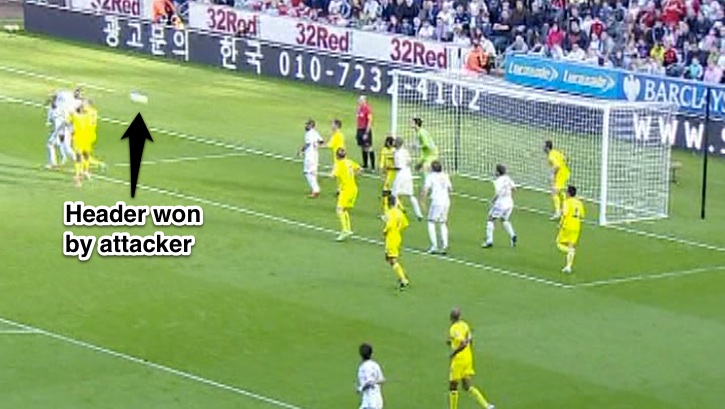
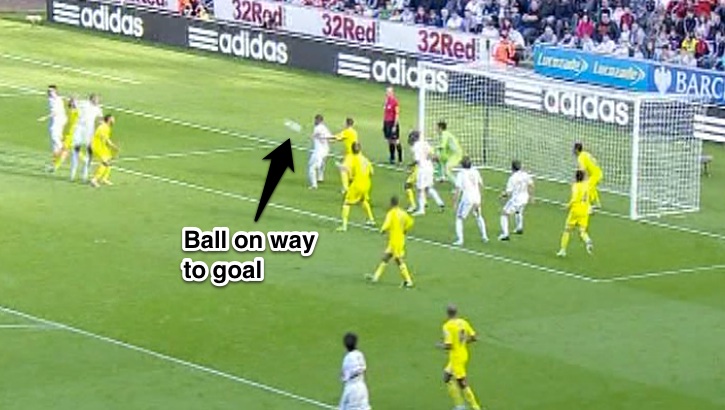
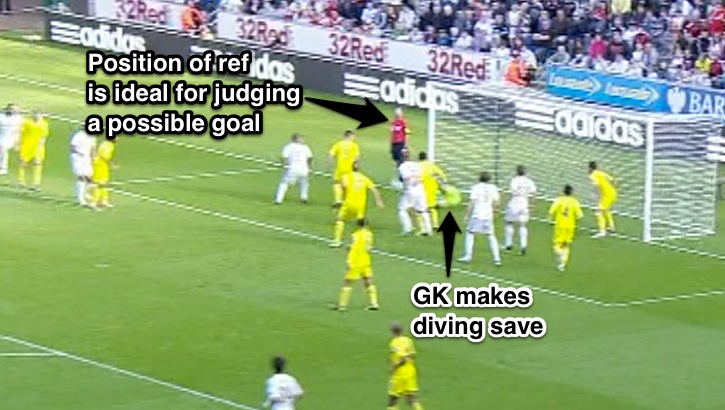
17 responses to “Case Study: Alternative Corner Kick Positioning”
I have used this position in the past, but I try to vary my position on corner kicks so the players do not know whrere I will be on any given kick.
LikeLike
I find it odd that he would do this on his own? Were there any problems on CKs previously during the game. Either the FA allows it in their GTP, they released some kind of memorandum like USSF does, or Mike Dean is going to hear an earful for this
LikeLike
I also use that position sometimes – always try to vary my position on corner kicks so players don’t know where I will be. It does leave me exposed to a quick counter, but I can make a sprint if I need to (just fewer of them per game)
LikeLike
In 14 years of refereeing, over time, I have migrated to that position on most corner kicks for all the reasons stated by Ed and Bob. Conventional wisdom has taught us to always try to posision to where the ball is likely to be ‘next’. I feel a corner kick is such a possible pivotal event in a match that I will take that chance of being 18 yards behind on possible quick counter-attack to having the best view of a real goal scoring opportunity.
LikeLike
Four things to note in this specific example:
1. All eleven defenders are in the penalty are (pic #2). That means this positioning may work well in this example as a quick counter attack leaves the referee only 15 yards behind as opposed to 50 yards behind if the top striker is at the mid-line.
2. If the argument is that the goal line position allows for the best view of action around the goal, pic 2 would seem to undermine this argument as the referee has lost visual contact with all but four players.
3. The goal line positioning takes the referee out of the positioning where he can keep his AR in view along with the ball/action. RefTalk can save him in the EPL, but most “regular” referees are putting themselves alone on an island with goal line positioning and run the risk of missing an AR’s call (ball out of play) that could save later controversial decisions.
4. Why is it important for the referee to be in position to judge the goal line in pic 5? That is the AR’s job.
LikeLike
I sometimes use this position, depending on the match. It is not always the best position to take. One example, what if the attackers are all in a line at the 18? Again, depending on the level of play and the flow of the match, it may be difficult to observe what goes on from this position at the moment the ball is struck. What about a short kick followed by a quick center? Too many variables to say for sure just “where” is the best position. I say, let the center stand where they feel most capable of calling play. I do love the book…..
LikeLike
Ed and I are indeed smiling, and we thank you for the generous words. But we need to straighten out a few misconceptions in the comments. We are not saying and have never said that the goal-line position is the ONLY one to take at a corner-kick or a free kick near goal. We have always said that it was a good position, one that referees should use more often.
But some of the comments seem like mere excuses not to try anything different from the standard dogma:
The “quick counter” excuse may apply in the PL but not in Sunday park football. Besides, why aren’t you fit enough to take that long fast run? We were! Throughout our forties . . .
A guide to positioning is only a GUIDE. Don’t follow it slavishly! Modify your movement to match the circumstances of the game, not the assessor’s demands!
Mike Dean is not the only one in the Premiership to use the deep position occasionally, and he’s not going to get an earful for it! If you have the fitness, use it!
And to Stephen, I will add this. Your points 3. and 4. I do not understand. As Ed and I know very well from an inswinging corner-kick in Argentina vs. Mexico (Ed was the referee), he could see me and I could see him when a critical decision had to be made (goal/no goal). Both officials on the goal-line; both got it right. No problem.
Final piece of wisdom: Assessors can educate referees, but many times, referees with more experience can educate assessors.
Cheers,
Bob Evans.
LikeLike
I used this position yesterday and it helped confirm a no goal situation.
LikeLike
With all respect to Bob (my dog-eared, highlighted and annotated copy is part of my ref bag gear), claiming the “quick counter” is an “excuse” for poor fitness is a bit of a self-serving misrepresentation. I’ve seen many a fit and fast “younger” referee end up more than 30 yards behind on a “Sunday park football” match using the GL position on a corner kick—I defy you to show us ANY human being actually outsprinting an 18 yard deficit AND the exit velocity of a well cleared ball. Particularly in amateur games, the wasted CK that’s cleared well past the halfway line is the NORM not the exception. Additionally, boxing play with my AR while being the same distance from the potential trouble near the top of the area as with the GL position, the only thing I’m giving up is the actual GL Angle of View. I’d like to see a film/video of the authors making such sprints. Then I would be happy to yield, flog myself for being not fit enough or as good as Bob and hang up my whistle. At the risk of disrespecting my elders, there are many places in the book where the authors seem to grandstand, and the comment above sounds so very familiar. I’d be more inclined to believe some video evidence. What I see IRL every week in the workplace tells me, the GL position for the REF on CKs is a rare position taken only for very specific purposes (history within that very match of shenanigans that you can only catch in that particular AOV). Even then NOT ONE REF in the world can outsprint and well cleared ball plus make up the deficit of the PA’s distance. Physics beats opinion.
LikeLike
JustJack,
Thanks for your comments, I think you make some important points.
What I have taken away from Messrs Evans and Bellion is that many aspects of refereeing involve evaluating risk-reward trade-offs. So, each of us has to evaluate whether the “risk” of being positioned on the goal line during a corner kick (and being out of position on a quick counter as you suggest) is worth the “reward”, in this case, being much closer to play and therefore being able to positively influence the behavior of the players.
If we go back to the original example from the Premier League, we see Mike Dean – a FIFA Referee – taking a position on the goal line. To be fair, I clipped the frames from a highlights show; I did not see the entire match. So, it is entirely possible that Dean was in a more traditional position at other times, but decided to take up the goal line position at this particular corner for some situational reason.
My point is this: even disregarding the opinions of Evans and Bellion, Dean, a current FIFA Referee who is clearly 15 to 20 years older than the players he is officiating, chose to take up the goal line position for this corner. For me, this fact alone makes goal line positioning worth considering, at least in some situations.
LikeLike
For JustJack, I would suggest that you do some analysis of what happens at corner kicks. You will find that the quick counter attack is a low percentage event. Most of the time, there is a goal kick, another corner, or a partial clearance which then gets played back into the PA, or the keeper collects and holds the ball before distributing it downfield. So the quick clearance to the halfway line is infrequent. And a referee who reads the game well can see what happens and set off at once. You are correct that no-one can run as fast as the ball is kicked out, but you can catch up pretty quickly the few times a game when needed.
One other issue that is seldom mentioned is that you are not in the way if the the play goes towards the 18 yard line, and are not taking away space from the players.
If anyone saw the Sheffield Wed/Leeds U game last week, (the one where the fan ran on and assaulted the SW keeper), you would have seen where the referee failed to see a defender punch the ball away from a right wing corner, because his view was blocked by all the other players between him and the goal line. Had he been on or near the goal line, he wouldhave seen it easily.
Look through our blogs web site to find examples of where this position was needed. The most well-known example is the France goal v. Ireland after the Thierry Henri handling.
I will look through my collection of videos of my own matches, and see if I can find such a situation of getting out to follow a quick clearance. If so I want to see you flogging yourself, but don’t hang up the whistle, just use this advice to improve.
About smiling, I would have been smiling even more if the AR had the flag in his right hand during the corner in the original photos!
Ed Bellion
LikeLike
I referee Adult recreational and youth, club & high school. I disagree with the notion that clearance to the halfway line on CK’s is a rarity. It’s the majority of times even in skilled competitive play U19 and below.
Other than that distinction. Advice well taken. I’ll gladly show you my vid if you show me yours, LOL 😉
LikeLike
Do the analysis like I suggested. And remember the difference between a clearance that comes right back in and one that leads to an actual attack on goal at the other end. They are the rarities.
Even in amateur matches. We did referee those as well and currently assess matches at that level as well at the higher levels, so we are not just talking about top level pro stuff.
LikeLike
I have a couple comments. First to Mr. Evans, with all due respect (and I do love reading your blog btw), yes we should all be fit and able to recover from positions like this. However, the fact is at the level many of us are working in (Youth matches on Sunday afternoons up to maybe semi-pro levels at best), a good number of those referees simply are not as fit as they should be and I wouldn’t want to see them taking a position like this. Personally, I bust my butt to stay in top shape but I can still be out-sprinted down the field by some of the faster U18 players I see regularly.
Second, at least from a USSF perspective, part of the teaching on this is about getting a different angle than you A/R while still keeping them in sight. While yes, you do technically have a different angle, you’re both on the goal line looking outward. None of the activity on the fringes is visible and as mentioned it is much harder to keep your AR in your vision. So a referee who chooses to use this position must be aware of that and be prepared to shift to a new position quickly. Which brings me to my third point.
With the position on the goal line near the post, it is much harder for the referee to leave this position. You now have to run around or through the large group of players in order to move to any other position on the pitch. This more so than fitness could be a limiting factor in your ability to recover on a long counter as the defending team’s backs and attacking team’s strikers may not be moving up field as fast as you need to and could be obstacles in your recovery.
I’ve tried this position in a couple games. For the points I raised above, I found it to not be a comfortable position for me. I keep it in my toolbox as something I still use in rare occasions when I feel there’s a need for me to have that view, but honestly varying my position within the PA more often then not allows me to find a great angle without being in the players way and without being in a position that could leave me trapped. I find the need for this position to be more rare than perhaps Mr. Evans and Mr. Bellion have, but I do keep it in mind as an additional tool as I agree with them we all should. The sentiment of being open to trying other tactics beyond the generally accepted methods is one I personally take to heart and thing other referees should as well.
LikeLike
Been assessed more than half a dozen times in last four years and I have yet to get a single positive feedback from any of them for the position on corner kicks and other set plays close to the goal line. Now-a-days I take a ‘pseudo-dynamic’ position anywhere from in line of the goal area and the goal line, at least once or twice each half, especially with certain teams. It has worked almost every time, even with a single point of control (solo). As for the pushing and pulling (jerseys), during these set pieces, I try and nip them early. What became interesting in one match was when the defenders saw me directly behind them, they sent two forwards instead of their usual lone striker, cleared the ball up-field. The defenders were faster, and not much later, this yellow shirt was close enough on that counter. Sometimes, it helps to know what the players are going to do next. And that is the game people play. Most Sat-Sun league matches have unlimited substitutions, don’t they? Well, the fellow who does not get substituted is the chap in the middle, which would suggest s/he is physically able to keep up with the demands of that match. A higher work-rate than the players, right? So be it, always.
Now, if only, the [us] federation assessors would be able to also see that the demands of the game requires such positioning, one can always hope, can’t one? It only takes a couple decades for changes to occur, and who better to tell you that other than the smiling duo.
LikeLike
I keep this as a tool in my toolbox but only in rare cases where it’s called for. Definitely is not a position I use regularly. As someone else mentioned, this works if you’ve got 20 players in the PA. However if you’ve got a striker or two from the defending team at mid-field, the chances of getting caught out of position on a quick counter go way up. Also, I find that this positioning in many cases puts me too close to the players. You lose the “big picture” perspective and your field of vision becomes limited to only a few players, that’s not good. Finally, I never like it when I and my AR are looking down the same straight line at the play as this limits our combined view of the play. With both the AR and the Referee on the goal line, the chances that both will end up looking straight through each other is high and that can make it harder to see the action as well. Now that said, if I’m having problems on CK’s or suspect something is going on, I do have this as a tool in my toolbox. I just can’t get on board with Mr. Evans that this is an optimum position under most cases.
LikeLike
Personally I love the alternate position, it has helped me make multiple key decisions in multiple games. One particular stands out that happened only a month ago when on the corner the ball went directly to the keeper. Perhaps 12 players surrounded him but I could see from the goal line no one made contact with the keeper who then lost control of the ball. The ball then bounced off the hip of an attacker and into the goal. Members of the defending team looked towards the traditional position with hands raised prepared to protest, but they were not aware I was standing close enough to the keeper to see the sweat drip from his chin. I was able to dispell any protest just by standing there when they looked at me. Had I been in the traditional position, I doubt I would have been able to see the no-contact, and the part of the body the goal was scored on leaving me two chances to incorrectly disallow a goal for something I couldn’t properly see. While I doubt that I would have, I can attest that the alternate position was the best possible. However the only time I ever use the alternate position is when:
A: The corner is being taken on the side opposite the AR
B: After it becomes clear that the team will not be taking a short corner
C: When I am confident enough in my speed vs the speed of the players that a quick counter will not leave me 50 yards off play.
If the corner is on the AR’s side of the field I prefer to be positioned somewhere on the right half of the penalty arc, this insures the players are usually coming towards you. The same benefit as to when you take up the alternate position on the corner which the AR is not present.
When there is the threat of a team taking a short corner it leaves me in too awkward of a position to recover from and make a correct call in the flow of play. I also tend to be a touch slower than most college level players and upper level U-19 players, at this level my personal speed leaves me too vulnerable to the counter attack. Just my personal experience.
LikeLike